The Glasgow Subway - A History Part 1 (1896-1977)
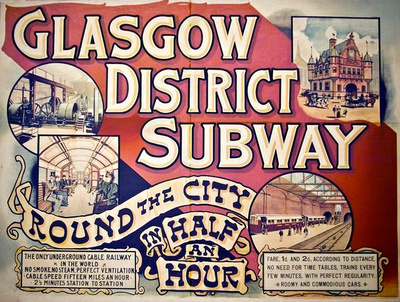
 Introduction
Introduction
The Glasgow Subway is the third oldest Undergound system in the world, having opened in 1896, with only the London and Budapest systems being older. Originally known as the Glasgow District Subway and later as the Glasgow Underground, the Subway has also garnered the nickname 'the Clockwork Orange' and has even been described as 'A Giant Trainset'! Throughout the course of it's history, this small 6 1/2 mile circular route with a unique 4 foot gauge, has never expanded in size. Despite this, the history of this rather unique Subway, particularly pre 1977 is a fascinating one!
History
The Glasgow and District Subway Company was formed in the late 1880's with the intention of building and running a Subterrainian railway around the then compact city of Glasgow.
Early Proposals
The first proposal was for an 2 3/4 mile underground cable railway running from St Enoch Square to Byres road via Buchanan Street, Garscube Road, Kelvin Bridge and Botanic Gardens, with 'driverless trains' hauled by a rope stopping at equi-distant island platform stations 700 yards apart and interlaced tracks between stations. This first plan was rejected due to the high risk of collisions. A second proposal was launched and was mostly identical to today's Subway route with twin 6 1/2 mile long circular lines passing underneath the River Clyde twice and the River Kelvin once. This plan was also rejected as a number of interested parties, particularly from the shipping companies and ship yards were worried that if the line was constructed, it would mean that the depth of the River Clyde could not be increased by dredging to allow larger ships to head further up stream towards the city centre.
Objections to the the Subway's proposals to build their line could not be justified following the Glasgow Harbour Tunnel Company gaining approval and Parliamentary assent for the constuction of a trio of tunnels under the Clyde at Finnieston in 1889. The Glasgow Harbour Company's plans were for two outer tunnels for horse drawn vehicles and a centre tunnel for pedestrians reached by hydraulic lifts from what are now the listed rotunda buildings on either side of the river near to today's SECC and the STV Studios. Unsurprisingly, the Glasgow and District Subway Company resubmitted their bill with ammendments to the route around Bridge Street and also in taking the line slightly further west towards Merkland Street (Partick) and the proposals were passed!
Construction begins and the Cable hauled era
Construction work began at St Enoch Square in March 1891 and with a mixture of different construction methods including cut and cover, brick lined tunnels, building concrete platform chambers at each of the 15 stations, the fitting of cast iron tunnel rings and burrowing under the streets of Glasgow and under the River Clyde (twice) and the River Kelvin, where the air pressure had to be adjusted and air locks used.
Stations
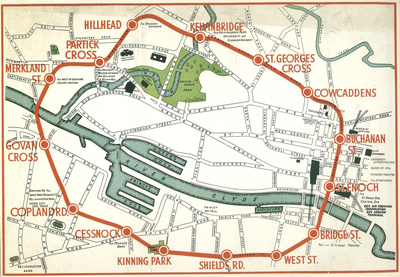
 Fifteen stations were built around the 6 1/2 mile line, these were: St Enoch, Buchanan Street, Cowcaddens, St George's Cross, Kelvinbridge, Hillhead, Partick Cross, Merkland Street, Govan Cross, Copland Road, Cessnock, Kinning Park, Shields Road, West Street and Bridge Street.
Fifteen stations were built around the 6 1/2 mile line, these were: St Enoch, Buchanan Street, Cowcaddens, St George's Cross, Kelvinbridge, Hillhead, Partick Cross, Merkland Street, Govan Cross, Copland Road, Cessnock, Kinning Park, Shields Road, West Street and Bridge Street.
At platform level, the layout of each station was almost identical, each station had an island platform, which was decked using wooden planks, there was only one staircase that served both as the entrance and exit to the platform and fourteen of the fifteen stations had the same width of platform, with only Kelvinbridge having a wider platform, while Cowcaddens had (and still has) the longest platform. In most stations, at least part of the platform chamber was covered by a glass ceiling to let light into what would otherwise have been a really dark environment as electrical lighting was in it's infancy at that time and would have been low powered. An attempt was made to lighten the platform chambers and passageways by whitewashing them, however they soon became unsightly and stained.
From street level, most stations were accessed from ground floor or basement level of tenements and shops that were already in situ. Some of the smaller stops such as West Street and Kinning Park had their own small brick built entrance buildings, but for the most part, the station frontages were of the 'blink and you'll miss it' category!
Copland Road, was another station with it's own building, as it was /is (now called Ibrox and totally rebuilt) the station that serves Rangers FC, it had (and still has) two entrances, one of which was the matchday entrance / exit and only used for that purpose.
Kelvinbridge station, was and still is the station which is the deepest underground on the system due to the proximity of the River Kelvin. Kelvinbridge was unique as it was the only station on the original system to have a lift installed. Kelvinbridge also had two entrances, one from the bridge over the River Kelvin on Great Western Road and the other on South Woodside Road. The lift from the Great Western Road entrance did not go down to platform level, but to the same landing as that of the South Woodside Road entrance with stairs leading from this level down to the station.
As much as the majority of the stations could be at best described as being 'non descript', one building stood out as being impressive, that was St Enoch Subway Station. St Enoch station is based in St Enoch Square, right outside the imposing hotel and frontage of St Enoch Railway Station (which has long since been demolished and replaced by the St Enoch Shopping Centre), the ornate brown sandstone building, as well as being the entrance to the original station, also featured the headquarters and board room of the Glasgow District Subway Company on the first floor. The building survives today, having been jacked up onto a new concrete base and moved a few metres further into the square during the 1977-80 refurbishment of the system, however it found other uses, firstly as a travel centre and laterally as a Cafe Nero Coffee Shop.
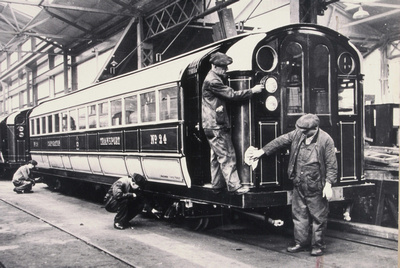
 Track, signalling and Depot
Track, signalling and Depot
The track was laid to the unusual gauge of 4ft, which the system retains to this day. The Outer Circle is 6.57 miles long and the Inner Circle is 6.55 miles long.
The original signalling was semaphore within a semi automatic block system. The signals were worked by a chain in the centre of the platform that was pulled by the stationmaster using a short pole.
As there was no junctions or crossovers anywhere on the system, both below ground or in depot, shunting on the road in which a car was located in depot was carried out by men pulling then with ropes wound round capstan winches. However if a car needed to be switched to a seperate track in depot e.g. if it was being moved to the paint shop, if it was required for service or if a car failed or needed removed from service, then there was only one way to move the car to a different track in depot or to/ from the tunnels, this was by crane!
Broomloan Depot was built over the top of the running lines near to Govan Cross station. In the depot building, there was an opening down to track level from the sheds. There was an electrically operated ceiling crane, which ran along its own specially made track and could pick up any of the cars, trailers or works vehicles. The crane had a lifting cradle with chains attached. These chains would then be attached to shackles on the car, which would allow the car to be lifted. If required, a car could be turned in mid air using the crane so that it would be facing the correct direction for the circle that it was going on to, then lowered down onto the track and unfastened. This was usually a very quick process and the process was identical if a car was being removed from a tunnel.
The process for the start and end of the service was an interesting one. After service each night, the trains would be stacked in the tunnels between Copland Road and the car sheds (Outer Circle) and Govan Cross and the car sheds (Inner Circle) for cleaning and light maintenance.
They would all be parked up bumper to bumper with their end doors removed to allow staff to walk right through from one end to the other. Apparently most shunting in the tunnels was done by gravity and it was a common sight to see a number of staff jumping up and down inside vehicles to get them to move to the right position! Vehicles that were required to be lifted were shunted under the car sheds pit and lifted by crane to the workshops and fresh cars lowered down.
The following morning each train left from their position from the night before and entered service, though the first train on both circles was designated as a key train, delivering the keys to open the stations to half a circle each before entering service at Buchanan Street (Outer) and St Enoch (Inner). All other trains entered service from Govan Cross (Outer) and Copeland Road (Inner), being called forward as required.
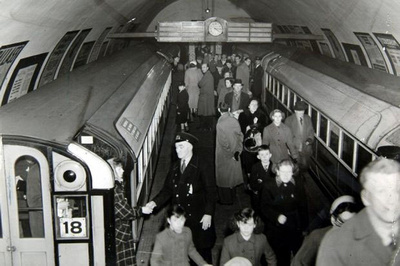
 Cable Power
Cable Power
From opening until the mid 1930's, the trains were hauled by cable, both circles were seperate entities with no junctions or crossovers, the cables being fed into the tunnels from two large drums in the Subway's own power station on Scotland Street, which was near Shields Road station at a constant speed of 12 mph (later increased to 13mph).
As well as operating the cables, Scotland Street also generated power for the station lights, car lighting, signalling system and telephone system. The cables were powered by two large steam engines and powered from 5 large boilers, which required coal to generate the amount of steam required. The coal required for the boilers was delivered to Scotland Street by rail, the power station having it's own private siding from the Glasgow and Paisley joint line. New and replacement cables were also delivered via this siding and old cable removed from here too.
Each cable left the Power Station and was fed into each circle, being carried round on a series of pulleys then back into the Power Station and returned to the drum. The cables were spliced together to allow for a continuous loop. Great skill and strength was required by the Gripper men, who were in control of driving the cars, they had to ensure that they stopped in the correct places on the platforms to allow a smooth acceleration out of stations, they had to avoid rough starts by gripping the cables too tightly from stations and also had to remember to release the cable at the appropriate times. They also had to beware of splices in the cable, they were not permitted to grip the cable on a splice in case it caused damage to the cable.
Rolling Stock - Gripper Cars
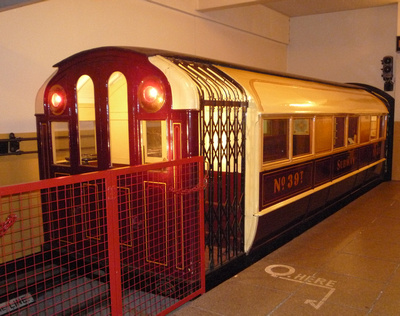
 For the opening of the line in 1896, there were 20 Gripper cars (numbered 1-20) built and delivered by Oldbury of Birmingham, with a further 10 (numbered 21-30) being delivered in 1897. The Gripper cars were named as such as their front bogie had a gripping mechanism attached that on a pull of a lever gripped onto the cable which was in the centre of the track. Each Gripper car was 40ft 9in long with a 32ft passenger saloon.
For the opening of the line in 1896, there were 20 Gripper cars (numbered 1-20) built and delivered by Oldbury of Birmingham, with a further 10 (numbered 21-30) being delivered in 1897. The Gripper cars were named as such as their front bogie had a gripping mechanism attached that on a pull of a lever gripped onto the cable which was in the centre of the track. Each Gripper car was 40ft 9in long with a 32ft passenger saloon.
Each car was built with a vestibule at either end, the front the 'Gripper Man' compartment and contained the lever for the gripper control, a braking wheel and an air brake. The rear vestibule was the guard compartment and was fitted with a braking wheel. Interestingly, the air brake was not used as the main brake and was only used as a last resort as each gripper car had an air tank fitted underneath the seating area. The air tank only had the capacity for the air brake to be used 40 times between refills. If required the air tanks could be topped up by connecting in an air pipe from a supply at West Street station.
The guard's compartment doubled up as the entrance for passengers and the Gripper Man's compartment at the front was the exit. In each vestibule there was a sliding door in the centre heading into the passenger saloon with removable doors on the ends to allow staff and passengers to move into another car when working in formation either with a trailer or as a trailer.
Rather than solid doors, trellis gates were used to enter and exit each car, however these were fitted to the right hand side of each car only. The passenger saloon was fitted out with longitudinal seating on wooden, non upholstered benches for 42 people with some internal dividers containing decorative glass placed in between.
The cars were lit by electricity despite being hauled by cable. Each car had two trolley poles attached to the left hand side of each Gripper car. These trolley poles drew electricity from continuous 'T' shaped steel bars on the tunnel walls known as 'T Irons'. As well as lighting the passenger saloons, lights were also positioned in the vestibules, in the front vestibule the light lined up with a small circular window and acted as a headlight, while in the rear vestibule the lights line up with two small circular windows with red glass to act as rear lights. Oil lamps were also carried as a back up. Externally, there was 14 window spaces on each side with every third window panelled over. The right hand side of each vehicle was painted maroon with cream window frames and cream roof, with the non visible left hand side of the car outshopped in all maroon. On the maroon area on the right hand side of each car, the words Glasgow District Subway were painted on along with the fleet number of the vehicle. The gripper equipment was attached to the lead bogie on the front of each gripper car and was positioned differently to on cars allocated to each circle. To make it easier for the maintenance crews, odd number cars were allocated to the inner circle and even numbers allocated to the outer circle.
First Day of Service

 The Glasgow District Subway opened it's doors to passengers on Monday 14th December 1896. Publicity had been low key, however the word had spread and queues started to form long before the service was due to begin! Once the stations opened their doors, many passengers spent the day travelling around in a circle, then when they got bored, crossed over and travelled on the other circle! Initially it had been planned to run 2 car trains (a Gripper car with a second gripper car on the rear acting as a trailer) on a 6 minute headway, however this was changed to single cars operating on a 3 minute headway and it would take 39 minutes for each car to do a complete circle.
The Glasgow District Subway opened it's doors to passengers on Monday 14th December 1896. Publicity had been low key, however the word had spread and queues started to form long before the service was due to begin! Once the stations opened their doors, many passengers spent the day travelling around in a circle, then when they got bored, crossed over and travelled on the other circle! Initially it had been planned to run 2 car trains (a Gripper car with a second gripper car on the rear acting as a trailer) on a 6 minute headway, however this was changed to single cars operating on a 3 minute headway and it would take 39 minutes for each car to do a complete circle.
At around 3pm, an outer circle train lost its grip on the cable and the passengers on board took it upon themselves to de-train and make their way through an unlit tunnel with the additional hazard of avoiding the cables, the cable pulley and avoiding touching the live T-irons on the tunnel walls.
A further more serious incident took place later that evening at 10.55pm on the Inner Circle, when car 15 had to stop short of St Enoch station and car 5 was allowed to depart Bridge Street and collided with the rear of car 15 causing damage to both cars. There were some injuries though luckily no one was killed.
Following this incident, the subway remained closed until 21st January 1897 to allow some changes to some of the procedures and adjustments to be made to ticketing such as introducing fare structures. Work was also done to the turnstyles at the ticket offices to stop fare evasion. A limit of 30 people on the platforms at any time was also introduced. Initially after reopening, 10 cars per circle were allocated, with one car from each circle being lifted to the car sheds nightly for maintenance and checks. A further 10 Gripper Cars, numbered 21-30 were purchased from Oldbury, Birmingham and were delivered and introduced to service early in 1897 and this allowed a number of the trains to be formed of 2 vehicles.
Further additions to the fleet
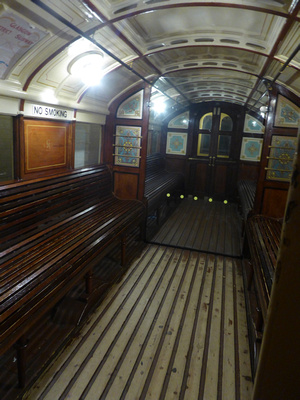
 The Subway immediately became a popular mode of transport for Glaswegians, especially the Merkland Street to Govan Cross section as it made travelling from one side of the Clyde to the other so much quicker and easier than it had been before the Subway opened. By 31st July 1897, over 4.1 million passengers had travelled on the system in just over 6 months! Owing to this popularity, the popularity of the Subway, further cars were required so in 1898, rather than ordering more gripper cars, the decision was taken to order 24 trailer cars numbered 31T - 54T from Hurst Nelson of Motherwell.
The Subway immediately became a popular mode of transport for Glaswegians, especially the Merkland Street to Govan Cross section as it made travelling from one side of the Clyde to the other so much quicker and easier than it had been before the Subway opened. By 31st July 1897, over 4.1 million passengers had travelled on the system in just over 6 months! Owing to this popularity, the popularity of the Subway, further cars were required so in 1898, rather than ordering more gripper cars, the decision was taken to order 24 trailer cars numbered 31T - 54T from Hurst Nelson of Motherwell.
The 24 trailers were 25 feet long with steel underframes. Unlike the bogie fitted Gripper cars, the trailers were fitted out with 4 wheels. The trailers had a seating capacity of 24 with 12 passengers seated on each side of the vehicle on logitudinal benches. Like the gripper cars, they had vestibules at either end of the vehicle, which had trellis gates fitted to the right hand side of the body to allow passengers to enter and exit the car. Each vestibule had a handbrake wheel for the guard to use in an emergency. As per the Gripper cars, the lighting in the vestibules was lined up with the small circular windows containing red glass to provide tail lights for the train. Electricity for the trailer lighting was obtained via a jumper cable from the leading car. The interior passenger saloons were almost identical to those of the Gripper car only smaller. Externally, there was 8 window spaces on each side with every third window panelled over. The right hand side of each vehicle was painted maroon with cream window frames and cream roof, with the non visible left hand side of the car outshopped in all maroon. On the maroon area on the right hand side of each car, the word 'Subway' was painted on along with the fleet number of the vehicle in the following format: 'No 39T'.
At this time, multiple formations of rolling stock was possible, these were:
- A single Gripper Car
- A pair of Gripper Cars with only the front car gripping the cable
- A Gripper Car and a short trailer
- A Gripper Car and a pair of short trailers.
A further four gripper cars (55-58) were ordered and delivered in 1901 in anticipation of increased traffic for the International Exhibition being held in Kelvingrove Park. A further pair of Gripper Cars, the last new cars delivered and to enter service on the Subway pre Modernisation (cars 59 and 60) were delivered in 1913, 55-60 were all identical to the 1896 and 1897 built Gripper cars.
It was discovered fairly soon after delivery that the short 4 wheel trailers were not ideal for the operation of the Subway, with their low capacity and lack of bogies making for a poor ride quality. Starting in 1902, fourteen of the trailers, were rebuilt with an extended underframe, which was mounted on bogies and fitted with air braking. The bodies of each vehicle were extended to fit on the newly extended underframes and became almost identical to the Gripper cars except they were slightly shorter and seated 42 passengers instead of 44. The trailers that were extended were: 31, 32, 34, 35, 36, 37, 38, 39, 41, 42, 43, 44, 45 and 52. The remainder of the unconverted trailers (33, 40, 46, 47, 48, 49, 50, 51, 53 and 54) were gradually withdrawn and scrapped by 1914. The Gripper cars were strictly non smoking, with smokers confined to the trailers. Staffing wise, three staff per train were required, there was the 'Gripper Man', a Guard / Conductor and a 'Smoker Boy', the conductor who dealt with the trailer and emptying the spitoons provided in the trailers for the smokers.
The Company Years
On 30th October 1897 a burst water main at the corner of Kelvin Street and Dumbarton Road at 8am led to water flowing into the Outer Circle tunnels between Merkland Street and Partick Cross stations. The pumps were unable to cope and the Water Department were called out. A repair was needed, which required the water supply to be turned off, which had the unfortunate side effect of turning off the Subway pumps as well! Trains continued to run through the affected area on the Outer Circle till 11am when by this time, water was coming up through the floorboards!
By 1901, the Subway was facing stiff competition from the Corporation's Trams and as such was losing passengers to them. To try and combat this, they tried reducing fairs to as little as 1/2p for travelling between 2 stations.
Working conditions for the staff weren't great with long shifts, 7 day weeks in most cases with no breaks. There was two shifts, the early shift and the late shift. The early shift was from 4.30am - 1pm and the late from 1pm till the end of service. Sunday shifts were worked by the early shift and were from 12.30pm till 10.40pm and they were expected to resume on early working from 4.30am the following morning.
Corporation take over
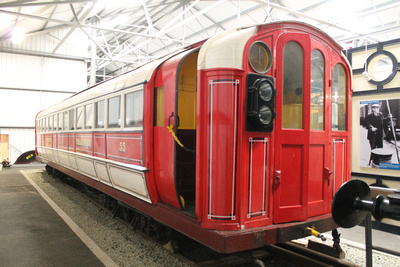
 By 1919, the Subway company was starting to get into financial difficulties and by 1922, the directors had decided to close the railway down. Glasgow Corporation had started negotiations to buy the subway and paid the company £200 per week for 6 weeks to keep the subway open. The Corporation's final offer to the Subway Company of £300,000 was rejected so the Corporation stopped their £200 a week payment and the Subway closed on 26th March 1922. Eventually negotiations restarted and following a figure of £381,589 was agreed between both parties and the Subway reopened on 3rd July 1922 and became part of the Corporation's Tramways Department.
By 1919, the Subway company was starting to get into financial difficulties and by 1922, the directors had decided to close the railway down. Glasgow Corporation had started negotiations to buy the subway and paid the company £200 per week for 6 weeks to keep the subway open. The Corporation's final offer to the Subway Company of £300,000 was rejected so the Corporation stopped their £200 a week payment and the Subway closed on 26th March 1922. Eventually negotiations restarted and following a figure of £381,589 was agreed between both parties and the Subway reopened on 3rd July 1922 and became part of the Corporation's Tramways Department.
The Corporation immediately made improvements by repainting the stations to make them more attractive to the public. The rolling stock was also repainted with the original maroon and cream livery going and a new red and white livery replacing it. The other change brought in was the increasing of the speed of the cable from 12 mph to 13 mph. Initial plans were beginning to be made to electrify the Subway, including the addition of sidings, building bigger car sheds and adding sidings and crossovers in the tunnels to allow stock to be stored off peak. Unfortunately these plans did not come to fruition due to the costs involved, however this was not the end of the electrification story.....
Electrification
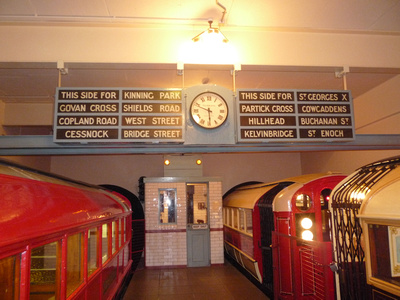
 In 1927 a battery locomotive was purchased from built by British Electric Vehicles, it was a 4 wheel jackshaft drive battery locomotive and would be used to haul a wagon with works materials to any work sites. By the early 1930's the subject of electrification came to the fore once more, along with options to build or buy in new cars, a change of gauge or seperate locomotive hauling the existing stock.
In 1927 a battery locomotive was purchased from built by British Electric Vehicles, it was a 4 wheel jackshaft drive battery locomotive and would be used to haul a wagon with works materials to any work sites. By the early 1930's the subject of electrification came to the fore once more, along with options to build or buy in new cars, a change of gauge or seperate locomotive hauling the existing stock.
West Street has always been one of the quietest stations on the system and from 1932 until 1953, the station remained closed on Sundays.
By 1932, a test track fitted with third rail was built outside the car sheds on the surface and a section of the Inner Circle between Merkland Street and Copeland Road was also fitted with third rail as the Corporation trialed electrification.
Gripper Car 60, the newest car in the fleet, was converted to electric traction, complete with new motorised bogies with shoes to pick up the currents from the third rail, though tram motors were used rather than the normal railway traction motors as larger bogies would be needed. Within the car, the driver's compartment received an electrical controller, with a driver's cubicle created by the fitting of a screen to cut out the draft coming from from the trellis gates, the other use of the screen being to protect the controls from the interest of passing passengers when exiting the car. The trellis gates received air engines to allow them to be controlled by the guard, also a cabinet containing most of the electrical gear for the car was fitted in the guard's compartment at the rear. The passenger saloon was also treated with the old wooden bench seating being replaced with upholstered seating.
Testing began in March 1933 both on the test track on the surface and during non traffic hours on the electrified area of the Inner Circle between Merkland Street and Copeland Road, often filled with 10 tons of 56lb weights . On 13th April 1933, Glasgow Corporation unanimously agreed to electrify the system. On 18th June, the railway inspectors came to visit and inspect car 60 and it's operation on the trial length of track on the Inner Circle. Car 60 managed to reach 26 mph during test, double the speed of the cable hauled trains. As well as inspecting Car 60 on test, the inspectorate also looked at the condition of the platforms, stations, ticket offices and signalling.
Following the visit of the railway inspectorate and on their recommendation, the wooden platforms were replaced with concrete platforms, the lighting was improved at platform level and in the passageways and staircases, with the stations also being fully repainted and retiled to improve their appearances and to make them brighter. Each station was fitted with a new clock in the centre of a back lit destination display, which showed the side to travel on to reach a station quickest (each station showed 7 destinations) and as a train approached the station, the display would light up showing which circle the approaching train was running on.
Each station had a stationmaster's office built on the end of the platform without the stairs, this office was fitted with a telephone system, section breaker switches to allow the station master to cut the power to the section of track before the station and after the station if required in an emergency. The station master's office also had the ability to control signalling in their section if required. The upgraded signalling system was an automatic colour light system that worked via the T iron electrical supply and included train stops. The train stops cut power to the train if it passed a red signal.
Improvements were also made up on the surface and in the passageways with the original barriers and turnstyles deemed to be a hazard in the event of a fire or evacuation by the railway inspectorate. The barriers were removed and the staffed ticket booths, which in most cases were at passageway level, were relocated close to the station entrances. One experiment that was way ahead of its time was coin operated ticket machines. These were installed on a trial basis at Hillhead station in 1935, however they weren't successful as passengers preferred to buy their tickets from the ticket booths.
Electrification was to take place one circle at a time with the Inner Circle being done first, followed by the Outer Circle. This meant that during the change over that sufficient rolling stock had to be available for the newly electrified Inner Circle and the cable hauled outer circle. To get enough cars ready for the Inner Circle being converted to electric power but leaving enough cars available for use on both circles, three outer circle (2, 12 and 24) and four inner circle gripper cars (3, 11, 15 and 25) were converted to electric traction and with car 60 already converted, there was 8 cars available. Gripper car 6 was also reconditioned for trailer operation at this time receiving new wheels. The final cable hauled train on the Inner Circle ran on Saturday 23rd March 1935, with electric trains starting on Sunday 31st March 1935, operation began with a 20mph speed restriction but was still a significant improvement on the cable hauled timings.
Once the Inner Circle began electric operation, a further 7 gripper cars became available for conversion to Motor Cars. Cars 1, 21, 23, 27, 29, 55 and 59 were the chosen cars and work began almost immediately both on them and on also on the upgrade of some more of the trailer cars to work with the motor cars. Meanwhile work was well underway on converting the Outer Circle for electric operation, however work was delayed. The final cable operated trains ran on the Outer Circle on Saturday 30th November 1935, with electric operation commencing on Thursday 5th December.
The process of stabling the trains at night remained the same in the electrification days as it did in the cable days in that the trains were lined up on either side of the car sheds lift. The only change to the process was that any train lifted for maintenance or overhaul (usually every 10 days) was put back into service on the opposite circle once available for service to even out wear. Electrification brought another advantage as once the 20mph speed restriction was lifted, a full circle could be completed in 28 minutes, 11 minutes faster than the 39 minutes taken in cable days. By 1936, further motor cars (16, 20, 29 and 58 )were converted to electric traction and available for use, with 16 converted trailers also being in use.
By 1936, the decision was taken to rename the Subway and it would become known as the Underground. Following the electrification of the system, the Corporation planned to extend the system with a line from Robroyston to Kings Park via Foresthall, Springburn, Sighthill, Pinkston, Buchanan Street, St Enoch, Bridge Street and Newlands. The expected cost of the line was £0.5 million per mile, and planning began in 1937, however the project was postponed due to World War 2 and was eventually abandoned.
By 1938 a further 6 ex gripper cars that had originally been converted to trailers, were converted to motor cars, numbers 6, 14, 17, 18 28 and 30 were chosen for the upgrade. Trailer Car 9 was chosen during 1939 to trial solid exterior doors, replacing the trellis gates that were fitted to all the cars. The trial was a success but further conversions would have to wait until after the war. After electrification, the number of passengers reached staggering proportions with 21.5 million passengers carried in a year up to 31st May 1937 and in the same period in 1940, this had increased to an incredible 26.7 million passengers!
Wartime
The Subway continued operating mostly unaffected during World War 2 until 18th September 1940 when a lone German bomber dropped a bomb, which landed on Beith Street Bowling Green near to Merkland Street station, which penetrated the lining of one of the tunnels causing serious damage. Due to the soft nature of the ground around the tunnels and the work required to rebuild the damaged area, rewire the affected area, resignalling and eventually relaying track, the Subway reopened on 27th January 1941 some 4 months after the bombing occurred. Wartime service levels were maintained at a very high frequency of running with 8 trains running per circle (32 cars) on weekdays, 9 on Saturdays (36 cars) and 6 (24 cars) on Sundays. One task that most of the station masters were relieved of from 1943 in a bid to save paper was the need to record every departure time from their stations, this applied to all bar St Enoch and Govan Cross stations who continued to keep the record.
Peace time
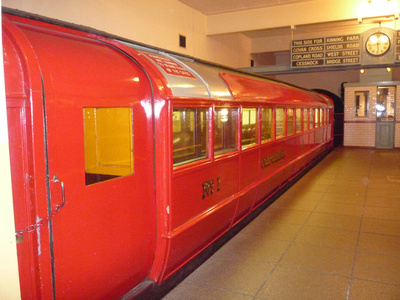
 Following the war, passenger numbers continued to rise reaching a peak in 1948-49 of a staggering total of 37.1 million passengers per year! An increase in passengers meant an increase in trains per circle with 9 on weekdays (36 in total), 10 on Saturdays (40 in total) and 7 on Sundays (28 cars) being the norm for a while.
Following the war, passenger numbers continued to rise reaching a peak in 1948-49 of a staggering total of 37.1 million passengers per year! An increase in passengers meant an increase in trains per circle with 9 on weekdays (36 in total), 10 on Saturdays (40 in total) and 7 on Sundays (28 cars) being the norm for a while.
An experiment was carried out in 1946 to improve the lighting inside the cars using flourescent lighting. Motor Cars 22 and 55 were chosen for this experiment, initially they were deemed to be too expensive to maintain and removed again but in later years, they became standard in the cars. The process of replacing trellis gates with solid doors resumed in 1948 with a further 3 trailer cars and 4 motor cars being treated between then and 1953 with more motor cars and trailers being treated from 1956 onwards.
Another plan for an extension in the form of an eastern circle was published in 1947 and would require 3 stops on the existing system (Buchanan Street, St Enoch and Bridge Street) to become exchange stations with new platforms built next to or below the existing one with new stops at Hutcheson Square, Richmond Park, Dalmarnock, Belvidere Hospital, Rigby Street, Carntyne, Dinart Street, Blochairn Street and Kennedy Street. Unfortunately there was no progress with the extension due to the costs involved.
In 1953, significant expansion work was carried out to Govan Cross station, with the addition of a depot office building and seperate exit, which left the existing passageway at the top of the stairs from the platform chamber. This building was at the opposite side of Greenhaugh Street from the existing building, which became entrance only and allowed for better passenger flow. The lower floor of the new building contained depot and cash office facilities, whilst the upper floor consisted of locker rooms and canteen facilities, which could also be used by tram and bus staff if required. The existing station entrance, which was part of a tenement building was refurbished and retiled to make it look more modern around this time, with other stations also being treated to a tidyup.
On 8th April 1954, whilst being prepared for lifting, the crane hook snapped and dropped the lifting cradle onto the roof of trailer car 32, causing major damage to the roof. A serious amount of repair work was required and the decision was taken to experiment with passenger flow on the car by adding a central set of solid doors in addition to the doors at the vestibule ends. Between 1955 and 1958, the entire fleet was repainted into a new, more simple all red livery, replacing the more ornate 1930s style Red and White livery.
Three car train
An interesting experiment took place from 1958 until 1967 where a three car train was formed using motor cars 56 and 3 as the outer cars and trailer 32 as the centre car. To be able to work in 3 car formation, motor cars 56 and 3 needed their control equipment adjusted and some motors cut out on both cars to stop them from knocking out the power to the rest of the Subway! Car 3 had it's offside T-Irons relocated from the front of the car, which was standard for all motor cars, to the rear of the car.
Trailer 32, had been fitted with a set of centre doors following a major overhaul. The overhaul occured as 32 had to have major repairs following the 1954 incident where the crane hook snapped and dropped the cradle on to the roof of the car resulting in the complete rebuilding of the roof. The opportunity was taken to fit the extra set of doors, which replaced 4 seats and made loading quicker. The additional length of the 3 car train meant that the front and the rear of the train was in the tunnels at most stations thus the front door of car 56 and the rear door of car 3 were locked out of use when running in 3 car formation.
The 3 car set was always used in the following formation: 56+32+3 and could only be used on Outer Circle. The 3 car set soon earned the nickname 'Sputnik' as it had a reputation of spending more time up in the sheds than it did in the tunnels and regularly had to be partly or fully lifted for faults or other issues to be dealt with.
The experiment with 3 car operation ended in 1967 following the withdrawal from service of car 3. Car 3's withdrawal was closely followed in 1968 by car 56. Trailer 32 remained in regular use and was used as a normal trailer on both circles until closure of the system for refurbishment in 1977.
Into the 1960s
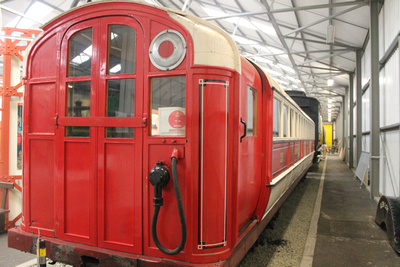
 From 1959 to 1963, the trailer cars, many of which were showing signs of their underframes drooping in the centre, were transported to Coplawhill Tram Workshops for strengthening work to be carried out on their underframes. Prior to this, 32 sets of trailer bogies were built and presumably fitted to the 1898 trailers which still retained their pre electrification bogies, they were also later fitted with new wheels to improve the ride quality.
From 1959 to 1963, the trailer cars, many of which were showing signs of their underframes drooping in the centre, were transported to Coplawhill Tram Workshops for strengthening work to be carried out on their underframes. Prior to this, 32 sets of trailer bogies were built and presumably fitted to the 1898 trailers which still retained their pre electrification bogies, they were also later fitted with new wheels to improve the ride quality.
In April 1964, Trailer car 35, whilst being fitted with solid doors and vestibule draught screens, the opportunity was taken to fit the trailer out with flourescent lighting. The fitting of the flourescent lighting was a huge success with only 3 out of 14 tubes needing replaced in a year and other cars followed. Another unique feature of trailer 35's refurbishment was the fitting of flexible hand grips, which greatly aided the standing passengers with holding on when needed. In 1968, Motor Car 17 was refurbished and also gained floursecent lighting, however it's diffusers were designed to take back lit advertisements and it was the only vehicle in the fleet to receive these. Car 17 and 18, which was next in line for refurbishment had their patterned glass dividers in the passenger saloons removed and replaced with decorative laminate with oval glass in them to give the interiors a more modern look. Cars 17 and 18 were the only ones to receive this treatment. In total, 28 cars received flourescent lighting, though initially until modifications were made to signalling circuits, it was not possible to have a train made up of 2 vehicles containing flourescent lighting due to the reduced voltage required!
In 1965, Glasgow Corporation opened it's first Park and Ride, having acquired the land formerly occupied by the British Railways goods yard at Kelvinbridge. The 250 space car park was convieniently situated for Kelvinbridge Underground Station and the attendant, sold joint parking and Underground tickets. The station it's self also had work done around this time, with the lift, which had been out of use since 1938 being reinstated and a new ticket office being built at a more convienient point in the station to allow a single ticket office to be available for passengers using the lift and those coming from the South Woodside Road entrance. From 1965 until 1975, the standard daily output was 8 trains (32 cars in total) per circle on weekdays and 9 (36 cars in total) on Saturdays and 7 trains per circle (28 cars in total) on a Sunday.
St George's Cross's entrance was built into a tenement, that was in line for demolition. The original entrance was demolished in 1970 and a completely new surface building containing a tower with a large letter 'U' on the top was opened in 1971. This building was retained when the Subway was closed for refurbishment in 1977.
On 30th January 1972, the lifting crane's hook snapped again causing the lifting frame to fall onto and damage trailer car 32, the same car as was damaged by the falling lifting frame previously! 32 was repaired and returned to service remaining in service till the Subway closed for refurbishment.
In 1974, Glasgow and Strathclyde Universities were commissioned to produce a documentry about the history of the system and to some of the traditional practices and character of the system before closure. Part of the film involved the producers wanting to depict the days of cable operation, however as they had no footage from that time, trailer car 41, which was under overhaul but retained trellis gates and bulb lighting and due a repaint, was repainted back into 1896 Glasgow District Subway livery. The scenes from the cable days were shot at Merkland Street one night after hours and involved a number of staff members dressed up in Edwardian costume filming with 41! Trailer 41 retained the livery until it the closure of the system for refurbishment.
Countdown to refurbishment
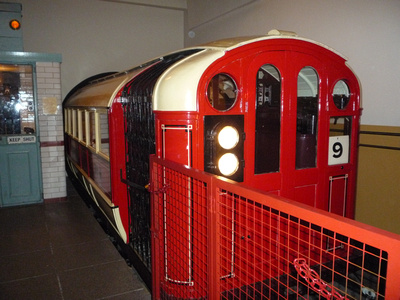
 In the final years prior to refurbishment, the stations were beginning to look derelict and the reliability of the trains was beginning to decline due to difficulties in obtaining spare parts for the now obsolete stock. By 1974 the announcement was made that the system would be upgraded with upgraded and rebuilt stations, new stations, an upgraded and expanded depot with access ramps to and from the tunnel with lifting in and out becoming a thing of the past.
In the final years prior to refurbishment, the stations were beginning to look derelict and the reliability of the trains was beginning to decline due to difficulties in obtaining spare parts for the now obsolete stock. By 1974 the announcement was made that the system would be upgraded with upgraded and rebuilt stations, new stations, an upgraded and expanded depot with access ramps to and from the tunnel with lifting in and out becoming a thing of the past.
It was expected initally that modernisation work would be done a circle at a time to allow the system to remain open, however the decision was made to close the system for the work to take place. Work was scheduled to begin in May 1977, with preliminary works occuring before closure. Most of the preliminary works were around the area where the new depot turnouts were to be located between Copeland Road and Govan Cross with piling work occuring and foundation laying work. Work also commenced at Govan Cross, where the station was to be expanded to have side platforms. Preliminary work at Govan Cross included the demolition of the 1950's built depot office and exit building and piling work to create the new platform chamber. An unfortunate side effect of this work was that cracks were starting to appear in the platform chamber arch in the existing Govan Cross station on 24th March 1977. The Underground was closed on discovery of the cracks and remained closed until Monday 2nd May, by which time the builders had exposed the outside of the station arch and had attached beams and wires to it to strengthen it.
Plans were made for the official closure of the Underground for refurbishment to happen on Saturday 28th May 1977, with a special service operating from 10am till late afternoon on Sunday 29th May after which, a special train running on the Inner Circle from Buchanan Street to St Enoch via the full circle containing invited guests, with the system offically being closed outside St Enoch's station. Special commemorative tickets were also to be issued throughout the last week. Unfortunately, these plans never came to fruition as more cracks were discovered in the station chamber at Govan Cross Station resulting in the service being suspended at 12.50pm on Saturday 21st May 1977 and not resuming again leading to the premature closure of the system 8 days early.
Trains in service on the last day of operation were:
| Outer Circle | Train | Inner Circle | Train |
| Route 2 | 17+19 | Route 12 | 55+9 |
| Route 4 | 29+8 | Route 14 | 57+52 |
| Route 6 | 24+5 | Route 16 | 25+39 |
| Route 7 | 27(20)+38 | Route 17 | 11+43 |
Motor Car 27 was lifted during the morning and replaced with Car 20. Trailer 38 remained in service throughout. An unofficial farewell trip on the southside of the Inner Circle was held on Wednesday 25th May.

 After the system closed for refurbishment, Motor Car 55 and Trailer 32 were used to transport a number of large items from the stations that were being kept or auctioned off round to the car sheds, where they were lifted out and the items transferred elsewhere. 32 was specifically chosen for this purpose due to the extra set of double doors that were built in for the 3 car train experiment. An auction of different pieces of redundant kit and memorabilia was held not long after work began on the refurbishment.
After the system closed for refurbishment, Motor Car 55 and Trailer 32 were used to transport a number of large items from the stations that were being kept or auctioned off round to the car sheds, where they were lifted out and the items transferred elsewhere. 32 was specifically chosen for this purpose due to the extra set of double doors that were built in for the 3 car train experiment. An auction of different pieces of redundant kit and memorabilia was held not long after work began on the refurbishment.
As work began, at Merkland Street the contents of the platform chamber was stripped out piece by piece, including the destination indicators, the signals, signage, the station master's office complete with circuit breaker and signal controls and some track, third rail and T Iron were moved to the Transport Museum and rebuilt as a display. Also making their way to the Transport Museum were Car 1 in its final condition, Trailer car 4, which was split in half for display as if partially in a tunnel, trailer 39, which was shortened back to it's original form and repainted into Glasgow District Subway livery and eventually the Battery powered locomotive also joined the collection.
Trailer 41 was shortened back to original length and split on it's longitude and put on display in the new ticket hall at Buchanan Street Station and repainted in its original livery. Car 55 was originally retained by the Greater Glasgow Transport Authority (later SPT) and was restored for the Centenary in 1996 for static display, later being donated to the Scottish Railway Museum at Bo'ness, where it is on display today. Trailer Car 7 also survives as and has found a new role as a cafe somewhere in England.
Motor Cars 6, 14, 15, 17, 19, 21 and 30 were transferred to Beamish, where they were stripped for spare parts for their tram fleet then scrapped.
Four cars were repurposed with their bodies being scrapped and their underframes finding use as permanent way vehicles on the current system, these are cars 2, 16, 20 and 57. The underframes of Cars 2 & 20 became W2 & W20 and became rail wagons, whilst 16 & 57 became W16 & W57 and were converted to cable laying wagons, with W57 later being adapted with an electrically powered air compressor to allow equipment to be used underground.
1st Generation Fleet List
| Number | Built | Built by | Type as Built | Type on conversion to Electric Traction | Withdrawn from Passenger Traffic | Solid Doors Fitted | Flourescent lighting | Current Status | Notes |
| 1 | 1896 | Oldbury | Gripper Car | Motor Car | 1977 | yes | yes | Preserved | Preserved in final condition, was in Museum of transport, now in store at Glasgow Museum Resources store at Nitshill |
| 2 | 1896 | Oldbury | Gripper Car | Motor Car | 1976 | yes | no | Works Vehicle | Body scrapped and underframe converted to railwagon 1983 |
| 3 | 1896 | Oldbury | Gripper Car | Motor Car | 1967 | no | no | Scrapped | Converted to camshaft control to allow it to work as part of a 3 car train with motor car 56 and trailer 32 |
| 4 | 1896 | Oldbury | Gripper Car | Trailer | 1977 | no | no | Preserved | body cut in 2 and one half used as part of a display at Transport Museum, Now Riverside museum |
| 5 | 1896 | Oldbury | Gripper Car | Trailer | 1977 | yes | no | Scrapped | Scrapped by Arnott Young, Dalmuir |
| 6 | 1896 | Oldbury | Gripper Car | Motor Car | 1977 | yes | yes | Scrapped | Transferred to Beamish for removal of reusable parts then scrapped |
| 7 | 1896 | Oldbury | Gripper Car | Trailer | 1977 | no | no | Preserved | Last known location, Southam, Warwickshire, interior converted to a café was up for sale 2018 |
| 8 | 1896 | Oldbury | Gripper Car | Trailer | 1977 | no | no | Scrapped | Scrapped by Arnott Young, Dalmuir |
| 9 | 1896 | Oldbury | Gripper Car | Trailer | 1977 | yes | yes | Scrapped | Scrapped by Arnott Young, Dalmuir |
| 10 | 1896 | Oldbury | Gripper Car | Trailer | 1977 | no | no | Scrapped | Was privately purchased to a location on Arran, now disintegrated, presumed scrapped |
| 11 | 1896 | Oldbury | Gripper Car | Motor Car | 1977 | yes | yes | Scrapped | |
| 12 | 1896 | Oldbury | Gripper Car | Motor Car | 1975 | yes | yes | Scrapped | Scrapped by Arnott Young, Dalmuir |
| 13 | 1896 | Oldbury | Gripper Car | Trailer | 1977 | yes | yes | Scrapped | Was used as a store at Bridge Street during the 1977-1980 refurbishment of the system |
| 14 | 1896 | Oldbury | Gripper Car | Motor Car | 1977 | yes | no | Scrapped | Transferred to Beamish for removal of reusable parts then scrapped |
| 15 | 1896 | Oldbury | Gripper Car | Motor Car | 1977 | yes | yes | Scrapped | Transferred to Beamish for removal of reusable parts then scrapped |
| 16 | 1896 | Oldbury | Gripper Car | Motor Car | 1976 | yes | no | Works Vehicle | Body scrapped and underframe converted to a cable wagon 1983 |
| 17 | 1896 | Oldbury | Gripper Car | Motor Car | 1977 | yes | yes | Scrapped | Transferred to Beamish for removal of reusable parts then scrapped |
| 18 | 1896 | Oldbury | Gripper Car | Motor Car | 1977 | yes | yes | Scrapped | |
| 19 | 1896 | Oldbury | Gripper Car | Trailer | 1977 | yes | no | Scrapped | Transferred to Beamish for removal of reusable parts then scrapped |
| 20 | 1896 | Oldbury | Gripper Car | Motor Car | 1977 | yes | no | Works Vehicle | Body scrapped and underframe converted to railwagon 1983 |
| 21 | 1897 | Oldbury | Gripper Car | Motor Car | 1977 | yes | no | Scrapped | Transferred to Beamish for removal of reusable parts then scrapped |
| 22 | 1897 | Oldbury | Gripper Car | Trailer | 1977 | yes | no | Scrapped | Was used to trial Fluorescent lighting in 1946 |
| 23 | 1897 | Oldbury | Gripper Car | Motor Car | 1977 | yes | no | Scrapped | Scrapped by Arnott Young, Dalmuir |
| 24 | 1897 | Oldbury | Gripper Car | Motor Car | 1977 | yes | yes | Scrapped | Scrapped by Arnott Young, Dalmuir |
| 25 | 1897 | Oldbury | Gripper Car | Motor Car | 1977 | yes | yes | Scrapped | Scrapped by Arnott Young, Dalmuir |
| 26 | 1897 | Oldbury | Gripper Car | Trailer | 1977 | yes | no | Scrapped | |
| 27 | 1897 | Oldbury | Gripper Car | Motor Car | 1977 | yes | no | Scrapped | Scrapped by Arnott Young, Dalmuir |
| 28 | 1897 | Oldbury | Gripper Car | Motor Car | 1968 | yes | no | Scrapped | |
| 29 | 1897 | Oldbury | Gripper Car | Motor Car | 1977 | yes | no | Scrapped | |
| 30 | 1897 | Oldbury | Gripper Car | Motor Car | 1977 | yes | yes | Scrapped | Transferred to Beamish for removal of reusable parts then scrapped |
| 31 | 1898 | Hurst Nelson | Short Trailer | Trailer | 1968 | no | no | Scrapped | Body lengthened and Extended from 4 wheel trailer to bogey trailer in 1900's/1910's |
| 32 | 1898 | Hurst Nelson | Short Trailer | Trailer | 1977 | yes | yes | Scrapped | Converted to camshaft control to allow it to work as part of a 3 car train with motor cars 56 and 3. Fitted with central double doors to aid passenger entry 1960s. Body lengthened and Extended from 4 wheel trailer to bogey trailer in 1900's/1910's. Broken up in Broomloan Depot 1990. |
| 33 | 1898 | Hurst Nelson | Short Trailer | N/A | 1914 | no | no | Scrapped | remained as 4 wheel trailer and scrapped in 1914 |
| 34 | 1898 | Hurst Nelson | Short Trailer | Trailer | 1977 | no | no | Scrapped | Had went to Ratho Inn near Edinburgh following withdrawal, now presumed scrapped. Body lengthened and Extended from 4 wheel trailer to bogey trailer in 1900's/1910's |
| 35 | 1898 | Hurst Nelson | Short Trailer | Trailer | 1977 | yes | yes | Scrapped | Body lengthened and Extended from 4 wheel trailer to bogey trailer in 1900's/1910's: Scrapped by Arnott Young, Dalmuir |
| 36 | 1898 | Hurst Nelson | Short Trailer | Trailer | 1969 | no | no | Scrapped | Body lengthened and Extended from 4 wheel trailer to bogey trailer in 1900's/1910's |
| 37 | 1898 | Hurst Nelson | Short Trailer | Trailer | 1977 | yes | yes | Scrapped | Body lengthened and Extended from 4 wheel trailer to bogey trailer in 1900's/1910's |
| 38 | 1898 | Hurst Nelson | Short Trailer | Trailer | 1977 | no | yes | Scrapped | Body lengthened and Extended from 4 wheel trailer to bogey trailer in 1900's/1910's |
| 39 | 1898 | Hurst Nelson | Short Trailer | Trailer | 1977 | no | no | Preserved | Body lengthened and Extended from 4 wheel trailer to bogey trailer in 1900's/1910's. On withdrawal, shortened back to 4 wheel trailer and original condition. Was on display in Transport Museum, now Riverside Museum Glasgow. |
| 40 | 1898 | Hurst Nelson | Short Trailer | N/A | 1914 | no | no | Scrapped | remained as 4 wheel trailer and scrapped in 1914 |
| 41 | 1898 | Hurst Nelson | Short Trailer | Trailer | 1977 | no | no | Preserved | Body lengthened and Extended from 4 wheel trailer to bogey trailer in 1900's/1910's: Received heritage repaint back into Glasgow District Subway livery in 1974. On withdrawal, cut back down to 4 wheel trailer and cut longitudely and displayed in Buchanan Street Subway until 2016. Removed and in store as part of the Glasgow Museum Collection at Nitshill store. |
| 42 | 1898 | Hurst Nelson | Short Trailer | Trailer | 1976 | no | no | Scrapped | Body lengthened and Extended from 4 wheel trailer to bogey trailer in 1900's/1910's: Withdrawn and scrapped following a collision in 1976 |
| 43 | 1898 | Hurst Nelson | Short Trailer | Trailer | 1977 | no | yes | Scrapped | Body lengthened and Extended from 4 wheel trailer to bogey trailer in 1900's/1910's: Scrapped by Arnott Young, Dalmuir |
| 44 | 1898 | Hurst Nelson | Short Trailer | Trailer | 1970 | no | no | Scrapped | |
| 45 | 1898 | Hurst Nelson | Short Trailer | N/a | 1976 | yes | no | Scrapped | Body lengthened and Extended from 4 wheel trailer to bogey trailer in 1900's/1910's: Withdrawn and scrapped following a collision in 1976 |
| 46 | 1898 | Hurst Nelson | Short Trailer | N/A | 1914 | no | no | Scrapped | remained as 4 wheel trailer and scrapped in 1914 |
| 47 | 1898 | Hurst Nelson | Short Trailer | N/A | 1914 | no | no | Scrapped | remained as 4 wheel trailer and scrapped in 1914 |
| 48 | 1898 | Hurst Nelson | Short Trailer | N/A | 1914 | no | no | Scrapped | remained as 4 wheel trailer and scrapped in 1914 |
| 49 | 1898 | Hurst Nelson | Short Trailer | N/A | 1914 | no | no | Scrapped | remained as 4 wheel trailer and scrapped in 1914 |
| 50 | 1898 | Hurst Nelson | Short Trailer | N/A | 1914 | no | no | Scrapped | remained as 4 wheel trailer and scrapped in 1914 |
| 51 | 1898 | Hurst Nelson | Short Trailer | N/A | 1914 | no | no | Scrapped | remained as 4 wheel trailer and scrapped in 1914 |
| 52 | 1898 | Hurst Nelson | Short Trailer | Trailer | 1977 | yes | no | Scrapped | Body lengthened and Extended from 4 wheel trailer to bogey trailer in 1900's/1910's: Scrapped by Arnott Young, Dalmuir |
| 53 | 1898 | Hurst Nelson | Short Trailer | N/A | 1914 | no | no | Scrapped | remained as 4 wheel trailer and scrapped in 1914 |
| 54 | 1898 | Hurst Nelson | Short Trailer | N/A | 1914 | no | no | Scrapped | remained as 4 wheel trailer and scrapped in 1914 |
| 55 | 1901 | Hurst Nelson | Gripper Car | Motor Car | 1977 | yes | no | Preserved | Was final car to operate on the Old Subway before closure along with trailer 32. Used to remove some large items from stations. Stored at Broomloan then restored to first GCT livery and displayed on centenary of Subway in 1996. Now on station display at the Scottish Railway Museum, Bo'ness |
| 56 | 1901 | Hurst Nelson | Gripper Car | Motor Car | 1968 | yes | no | Scrapped | Converted to camshaft control to allow it to work as part of a 3 car train with motor car 3 and trailer 32 |
| 57 | 1901 | Hurst Nelson | Gripper Car | Motor Car | 1977 | yes | yes | Works Vehicle | Body scrapped and underframe converted to form works car 1983 |
| 58 | 1901 | Hurst Nelson | Gripper Car | Motor Car | 1976 | yes | no | Scrapped | Withdrawn and scrapped following a collision in 1976 |
| 59 | 1913 | Hurst Nelson | Gripper Car | Motor Car | 1974 | yes | no | Scrapped | Withdrawn and scrapped following a collision in 1974 |
| 60 | 1913 | Hurst Nelson | Gripper Car | Motor Car | 1969 | yes | no | Scrapped | Car 60 was used as the test bed for Electrification back in 1933. |
1st Generation Works Fleet
- Battery Loco: built in 1927 by British Electric Vehicles, 4 wheel jackshaft drive battery locomotive. Rebuilt in 1937 with new cabs and chain drive. Withdrawn and put on display at Glasgow Museum of Transport. Now in store at the Glasgow Museums Store in Nitshill
- Wee Wagon' small 4 wheeled wagon used for transporting equipment around the system: Preserved and in store at Glasgow Muesum Store at Nitshill
- Bogie Wagons 1, 2 & 3: used for carrying permanent way equipment and rails around the system, fitted with hand brakes. Withdrawn and Scrapped 1977
- Compressor Wagon 1: built from an old coach bogie and used to transport an air compressor on system, Withdrawn and Scrapped 1977
- Welding Wagon 1: built from an old coach bogie and used to transport welding equipment on system, Withdrawn and Scrapped 1977